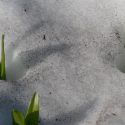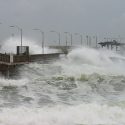The key to quieter Atlantic hurricane seasons may be blowing in the wind
Every year, storms over West Africa disturb millions of tons of dust and strong winds carry those particles into the skies over the Atlantic. According to a recent study led by University of Wisconsin–Madison atmospheric scientists, this dust from Africa directly affects ocean temperature, a key ingredient in Atlantic hurricane development.
"At least one third of the recent increase in Atlantic Ocean temperatures is due to a decrease in dust storms," says lead author Amato Evan, a researcher at UW–Madison’s Cooperative Institute for Meteorological Satellite Studies (CIMSS).
In a paper accepted for publication in "Geochemistry, Geophysics, Geosystems," the team of scientists describes how dust in the atmosphere cools the ocean by decreasing the amount of energy that reaches the water. The study also demonstrated that the large amount of dust blowing off of Africa in the 1980s and ’90s likely cooled the Atlantic enough to prevent conditions that could have resulted in more devastating hurricane seasons similar to 2004 and 2005.
As dust from Africa accumulates in the skies over the Atlantic, the atmosphere above the ocean begins to resemble the conditions over Africa. Millions of tons of dust create a drier environment and also reduce the amount of sunlight that reaches the ocean. Using a 25-year data record created by co-author Andrew Heidinger, a researcher with the National Oceanic and Atmospheric Administration (NOAA), Evan assessed how much the dust cooled the temperature of the ocean.
"It’s not just one dust storm," Evan says. "It’s the cumulative effect of several months of dust storms."
The 2007 Atlantic hurricane season, for example, was much quieter than predicted and the Atlantic was cooler than in previous years. Evan suggests that the relative lack of hurricane activity and cool ocean temperatures could be partially due to a particularly dusty spring and early summer. 2007 was the dustiest year since 1999.
By putting satellite observations and other atmospheric information into a computer simulation, Evan assessed how much energy reached the ocean with the dust in the atmosphere and then again after removing the dust. Evan found that dust cools the Atlantic by an average of one degree Celsius, about two degrees Fahrenheit, each year. In years with a lot of dust activity, such as the 1980s, the dust had a larger cooling effect.
In a study published in fall 2006 in "Geophysical Research Letters," Evan demonstrated that the intensity of hurricane seasons in the Atlantic increased when the amount of dust blowing off of Africa decreased and vice versa. The study published today is an effort to explain why this relationship exists and what the past few decades would have looked like without the effects of dust. Evan says these results confirm a direct connection between the intensity of dust storms in Africa and that of hurricanes in the Atlantic.
Because of the direct relationship, the amount of dust in the atmosphere could contribute to hurricane season forecasts. "Dust prediction is another tool to diagnose hurricane activity," Evan says. Evan has done some preliminary work to develop an effective way to use satellite observations to predict dust activity up to nine months in advance.
Dust storms in Africa have a significant impact on the temperature of the Atlantic Ocean, which, in turn, plays a large role in hurricane activity. Although climate change has taken the spotlight in media conversations about hurricanes, many factors influence these complicated storms. Of the effects of global warming, Evan says: "It’s real, but that’s not all there is."
Editor’s note: This paper has been accepted but has not yet been published. Journalists and public information officers of educational and scientific institutions (only) who have registered with AGU for direct electronic access and received a username and password, can download a PDF copy of this paper. Downloading instructions are here. Because this study is still a manuscript, AGU requests that journalists who report on it would please not directly quote from the manuscript.
Tags: climate change, international, weather



